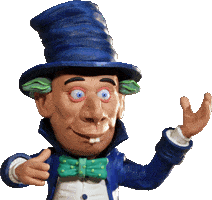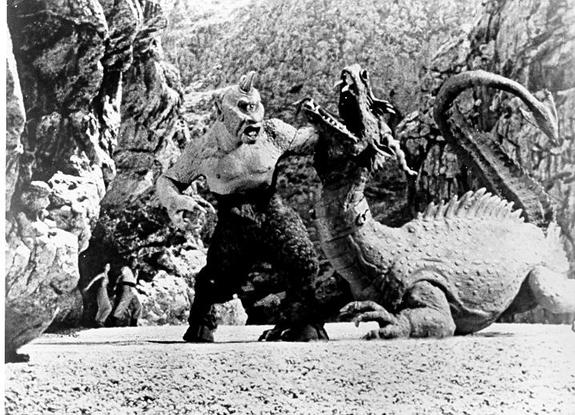


THE STOP MOTION ANIMATION HOW TO PAGE
Ray Harryhausen
by Jed Gibbs MA
Ray Harryhausen was born on the 29th of June, 1920. At the age of five Ray was entranced by the dinosaur movie 'The Lost World' and when he saw 'King Kong' he was "thirteen years old and very impressionable - and of course I didn't know how it was done at that time. Stop-motion was a secret, they kept it hidden for a good many years. A friend of my father's worked in a studio at RKO and he told me how it was done and I started doing it as a hobby in my garden and in my garage."
Both of these inspirational films were animated by the great Willis O'Brien. Ray visited 'Obie' and presented a stegosaurus model only to receive the advice "The legs look like wrinkled sausages. You’ve got to put more character into it and study anatomy to learn where the muscles connect to the bone."
Ray duly enrolled on art, anatomy and film-making classes. Harryhausen's concept art and storyboarding, so important to promote and visualise his ideas to producers, is exceptionally powerful. O'Brien had studied the engravings of Gustave Doré (illustrator of Danté's Inferno amongst others) for his use of light and shade on King Kong, and Doré also became a major influence on Ray.
From the age of 20, Harryhausen made some replacement-head 'Puppetoons' for George Pal, before enlisting in the US army in 1942. He was assigned to Frank Capra's film-making unit, mostly as a live-action cameraman but he also animated some maps and a few instructional films. Ray left the army in 1946 with a lot of 'out of date' colour film and used it to produce his own 'Mother Goose Stories' for schools. He had help from his father, an engineer who made the model armatures, and his mother, a seamstress who made the costumes.
Willis O'Brien then contacted Ray to help in the pre-production and making of 'Mighty Joe Young', completed in 1949. Although O'Brien received the Oscar and had been involved in the set ups, Ray had done most of the actual animation on this second famous ape picture. It was be the closest Ray would get to an Oscar until 1992, when he finally received one in his own name for 'lifetime achievement'.
Indeed the success of 'Mighty Joe Young' backfired on Ray. Stop-motion animation became seen as an expensive option that studios chose to avoid for their big pictures. Harryhausen found himself making low budget, B-movie monster movies with Producer Charles H. Schneer, who was to work in partnership with Ray for the next 25 years. Of the octopus in the 1955 film 'It came from Beneath the Sea' Ray says "The budget was so low I had to cut off 2 tentacles - so he was actually a sextopus." With budgets so small that the actors were often unknown, the positive side, as Schneer explained, was "we had full control, artistic control, without any interference - that was worth the price of making a B-picture as opposed to an A-picture".
After a while the monster movies began to lose appeal for Harryhausen, who "wanted to get away from the mad monster trampling down cities. I destroyed Washington, I destroyed San Francisco Golden Gate Bridge, I destroyed Coney Island in New York, and it gets tiresome. So we we looking for this new avenue, and mythology was ideal... in my youth they made mythological pictures, but you never saw the mythological creatures, they'd always talked about them off-stage. So I was bound and determined to put these creatures on the screen..." starting with 'The 7th Voyage of Sinbad' (1958).
Harryhausen was working without the benefit of modern aids such as video assistance to instantly replay his work in progress. Until the scene was complete and the film sent away for processing there was so much that could go wrong. Ray usually worked alone to help his concentration: "If the telephone rings and you go away to answer it, and you come back, and you say 'was that hydra's head moving forward?', and you'd wonder whether the third head was moving forward or backward..."
Charles H. Schneer: "There were times that he'd stay in the studio all night, clicking off a frame at a time, so that he could remember where he left off. He'd just pull up a bed alongside the camera and his foot was attached to a pedal that clicked off a frame." Another reason for working through the night was to maintain the color temperature of his lights - stopping mid sequence could result in unpleasant color shifts.
Perhaps the most famous scene Ray created features seven skeletons, conjured out of the ground in 'Jason and the Argonauts' (1963): "in the actual Greek mythology, rotting corpses come up out of the ground, and that wouldn't have been very pleasant - we'd probably have gotten an 'X'" (adults-only film rating, equivalent to UK '18' rating).
Much of Harryhausen's work involved cleverly combining his stop-motion craft with previously shot live action footage:
"The actors had to rehearse ahead of time... to get the feel of where their swords should stop. The actors had to shadow box and pretend that the skeleton was there of course, and that would be the piece of film that I would use to put the skeletons in."
To help keep the animation smooth Ray utilized position markers: "I've always used these machine shop tools so that you can put this in position on the skeleton... and you can know whether you have moved it a millimetre, or 2mm or 3mm."
Harryhausen developed several back projection and matting systems which Schneer enterprisingly dubbed 'Dynamation', 'Super Dynamation' and 'Dynarama.'
Ray Harryhausen's last film is 'Clash of the Titans' (1981) which had a larger budget and headline actors including Sir Laurence Olivier. The real stars were still Harryhausen's creatures, including his Medusa which featured in "one of the best sequences that I have ever done" - but "one gets tired being in a darkened room for over a year." Ray's enthusiasm began to wain following a number of stalled projects and rising competition from CGI (computer generated imagery).
Charles H. Schneer: "There were times that he'd stay in the studio all night, clicking off a frame at a time, so that he could remember where he left off. He'd just pull up a bed alongside the camera and his foot was attached to a pedal that clicked off a frame." Another reason for working through the night was to maintain the color temperature of his lights - stopping mid sequence could result in unpleasant color shifts.
Perhaps the most famous scene Ray created features seven skeletons, conjured out of the ground in 'Jason and the Argonauts' (1963): "in the actual Greek mythology, rotting corpses come up out of the ground, and that wouldn't have been very pleasant - we'd probably have gotten an 'X'" (adults-only film rating, equivalent to UK '18' rating).
Much of Harryhausen's work involved cleverly combining his stop-motion craft with previously shot live action footage:
"The actors had to rehearse ahead of time... to get the feel of where their swords should stop. The actors had to shadow box and pretend that the skeleton was there of course, and that would be the piece of film that I would use to put the skeletons in."
To help keep the animation smooth Ray utilized position markers: "I've always used these machine shop tools so that you can put this in position on the skeleton... and you can know whether you have moved it a millimetre, or 2mm or 3mm."
Harryhausen developed several back projection and matting systems which Schneer enterprisingly dubbed 'Dynamation', 'Super Dynamation' and 'Dynarama.'
Ray Harryhausen's last film is 'Clash of the Titans' (1981) which had a larger budget and headline actors including Sir Laurence Olivier. The real stars were still Harryhausen's creatures, including his Medusa which featured in "one of the best sequences that I have ever done" - but "one gets tired being in a darkened room for over a year." Ray's enthusiasm began to wain following a number of stalled projects and rising competition from CGI (computer generated imagery).
Charles H. Schneer: "It took 80 men to operate all the machines where it took him, one man, to do it"
James Cameron: "When you are a stop-motion animator you're actually taking the place of an entire film-crew, you are single-handedly creating a movie, so in a way you are the most unsung hero in Hollywood, but in another way you're also the most pure auteur... Ray was the ultimate vertically integrated creative entity... he would conceive of the character, often he would work out the story to allow these characters to come into being, then he would draw them, he would sculpt them and then he would bring them to life through the craft of stop-motion... he'd become the ultimate artist... it steps off the page, it steps off its little pedestal and comes to life".
Stan Winston: "When I think of Ray I think of him as a wonderful storyteller of the fantastic, I think of him as an actor"
Ray Harryhausen has influenced a great many directors and visual effects people. As Producer/Visual Effects Consultant Rick Baker says "How cool is that? Make monsters, and get paid to play with them. That is what I want to do when I grow up."
Many of the quotations are taken from 'Working with Dinosaurs' a 1999 documentary made for the UK Channel 4. This featured Ray Harryhausen's first stop-motion animation for nearly 20 years, demonstrating his technique.
Good sources for a full background and details of his films:
http://www.harryhausen100.com/podcasts/
https://www.rayharryhausen.com/
http://en.wikipedia.org/wiki/Harryhausen

















































